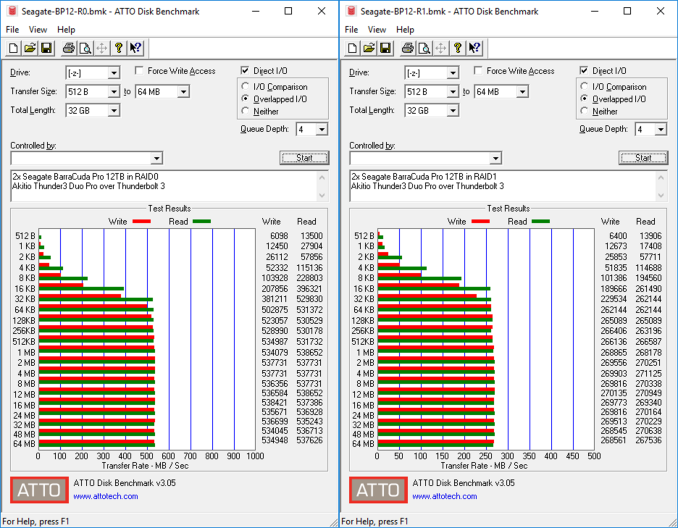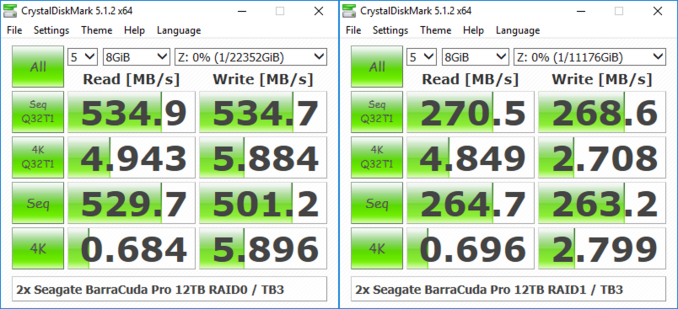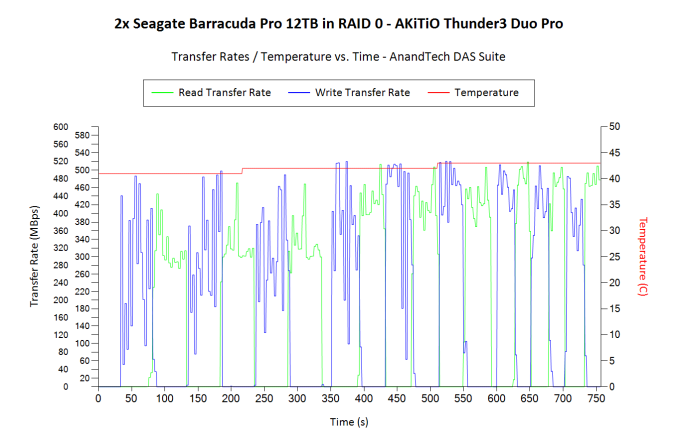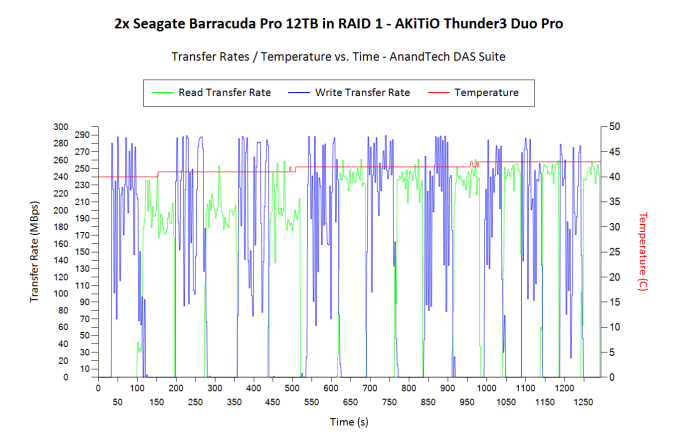Seagate BarraCuda Pro 12TB HDD Review
by Ganesh T S on November 15, 2017 8:00 AM EST- Posted in
- Storage
- Seagate
- HDDs
- Helium HDD
Performance - Direct Attached Storage Mode
Seagate suggests that the BarraCuda Pro Compute drives are suitable for use in direct-attached storage systems. We evaluated the performance in such a usage scenario using one of the highest performing 2-bay DAS units currently in the market - the Akitio Thunder3 Duo Pro, connected to our testbed via a Thunderbolt 3 interface.
Prior to processing real-life workloads, we first checked quick artificial access traces using ATTO and CrystalDiskMark.
We find that the performance remains consistent irrespective of workload size as long as the sequential access characteristic holds. Two drives in RAID 0 can sustain 530 MBps+ reads and writes. RAID 1 performance is similar to the standalone drive performance.
Both RAID0 and RAID1 configurations were subject to our standard DAS test suite described in the previous section. The robocopy test suite gave the following results.
| Akitio Thunder3 Duo Pro + 2x Seagate BarraCuda Pro 12TB (Thunderbolt 3) robocopy Benchmarks (MBps) |
||||
| Write Bandwidth | Read Bandwidth | |||
| RAID 0 | RAID 1 | RAID 0 | RAID 1 | |
| Photos | 334.00 | 215.79 | 303.85 | 184.12 |
| Videos | 432.76 | 221.45 | 396.39 | 222.44 |
| Blu-ray Folder | 421.10 | 219.98 | 434.73 | 224.72 |
There is no difference in the performance consistency between either RAID configuration. The behavior is largely similar to the internal drive scenario, except for the RAID 0 absolute bandwidth numbers. Thanks to the enclosure's fan, the temperature increase is also not as much as what we observed in the internal drive case.
We also processed select workloads from PCMark 8's storage bench.
| Akitio Thunder3 Duo Pro + 2x Seagate BarraCuda Pro 12TB (Thunderbolt 3) PCMark8 Storage Benchmarks (MBps) |
|||||
| Write Bandwidth | Read Bandwidth | ||||
| RAID 0 | RAID 1 | RAID 0 | RAID 1 | ||
| Adobe Photoshop (Light) | 313.76 | 201.22 | 10.51 | 9.16 | |
| Adobe Photoshop (Heavy) | 304.70 | 196.83 | 12.46 | 10.99 | |
| Adobe After Effects | 95.00 | 74.12 | 9.75 | 9.54 | |
| Adobe Illustrator | 214.10 | 168.92 | 9.39 | 9.11 | |
A significant speed-up in response time is achieved while dealing with multimedia files stored in a RAID 0 configuration of two BarraCuda Pro 12TB drives in a Thunderbolt 3 enclosure. Combined with the consistency shown, we can say that our results back up Segate's claims regarding the firmware tuning of BarraCuda Pro drives for specific application scenarios.














62 Comments
View All Comments
HStewart - Thursday, November 16, 2017 - link
Large amount of storage can be used for storage of logs and such especially when you have multiple locations. Of course you could have backupjameskatt - Sunday, November 19, 2017 - link
That is why you get three backups and an online backup.Arbie - Wednesday, November 15, 2017 - link
[Sorry, my question was for Ganesh, not the troll thread]I suppose it can be sussed out of the performance data, but... can you please say if this drive is shingle technology or not? With any Seagate drive that's one of my first questions, and they seem to have stopped identifying it in the literature.
ganeshts - Wednesday, November 15, 2017 - link
Oh, I covered that in the launch article, which is linked in the first paragraph.These are standard PMR drives, helium-ones with 8 platters.
XZerg - Wednesday, November 15, 2017 - link
I would suggest to include whether the drive is PMR, Shingled, ... storage in the table as both technologies co-exist but have different purpose/performance.Taracta - Wednesday, November 15, 2017 - link
Hello, the HD Tune random access are both Read not Read and Write. Please correct. Thank you.ganeshts - Wednesday, November 15, 2017 - link
My apologies! It has been fixed now.takeshi7 - Wednesday, November 15, 2017 - link
I really can't stand when people ask if a drive is SMR or "PMR". Every modern hard drive is PMR regardless of whether they are shingled or not. The proper term for a non-SMR drive is CMR.SMR - Shingled Magnetic Recording
CMR - Conventional Magnetic Recording
ganeshts - Wednesday, November 15, 2017 - link
That is a peeve I wouldn't object to, but, let us be honest - everyone treats SMR as the 'evolutionary update' to traditional PMR (CMR) drives. But, I appreciate this insight and will probably use it myself in future articles :)phoenix_rizzen - Wednesday, November 15, 2017 - link
To be pedantic, wouldn't SPMR and CPMR be more accurate?Shingled Perpendicular Magnetic Recording
Conventional Perpendicular Magnetic Recording